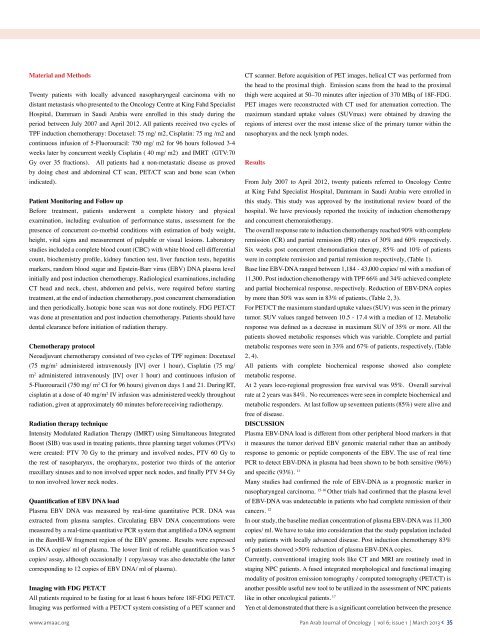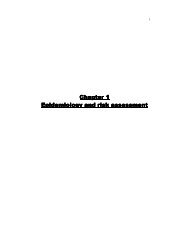Pan Arab Journal of Oncology - Arab Medical Association Against ...
Pan Arab Journal of Oncology - Arab Medical Association Against ...
Pan Arab Journal of Oncology - Arab Medical Association Against ...
You also want an ePaper? Increase the reach of your titles
YUMPU automatically turns print PDFs into web optimized ePapers that Google loves.
Material and MethodsTwenty patients with locally advanced nasopharyngeal carcinoma with nodistant metastasis who presented to the <strong>Oncology</strong> Centre at King Fahd SpecialistHospital, Dammam in Saudi <strong>Arab</strong>ia were enrolled in this study during theperiod between July 2007 and April 2012. All patients received two cycles <strong>of</strong>TPF induction chemotherapy: Docetaxel: 75 mg/ m2, Cisplatin: 75 mg /m2 andcontinuous infusion <strong>of</strong> 5-Fluorouracil: 750 mg/ m2 for 96 hours followed 3-4weeks later by concurrent weekly Cisplatin ( 40 mg/ m2) and IMRT (GTV:70Gy over 35 fractions). All patients had a non-metastatic disease as provedby doing chest and abdominal CT scan, PET/CT scan and bone scan (whenindicated).Patient Monitoring and Follow upBefore treatment, patients underwent a complete history and physicalexamination, including evaluation <strong>of</strong> performance status, assessment for thepresence <strong>of</strong> concurrent co-morbid conditions with estimation <strong>of</strong> body weight,height, vital signs and measurement <strong>of</strong> palpable or visual lesions. Laboratorystudies included a complete blood count (CBC) with white blood cell differentialcount, biochemistry pr<strong>of</strong>ile, kidney function test, liver function tests, hepatitismarkers, random blood sugar and Epstein-Barr virus (EBV) DNA plasma levelinitially and post induction chemotherapy. Radiological examinations, includingCT head and neck, chest, abdomen and pelvis, were required before startingtreatment, at the end <strong>of</strong> induction chemotherapy, post concurrent chemoradiationand then periodically. Isotopic bone scan was not done routinely. FDG PET/CTwas done at presentation and post induction chemotherapy. Patients should havedental clearance before initiation <strong>of</strong> radiation therapy.Chemotherapy protocolNeoadjuvant chemotherapy consisted <strong>of</strong> two cycles <strong>of</strong> TPF regimen: Docetaxel(75 mg/m 2 administered intravenously [IV] over 1 hour), Cisplatin (75 mg/m 2 administered intravenously [IV] over 1 hour) and continuous infusion <strong>of</strong>5-Fluorouracil (750 mg/ m 2 CI for 96 hours) given on days 1 and 21. During RT,cisplatin at a dose <strong>of</strong> 40 mg/m 2 IV infusion was administered weekly throughoutradiation, given at approximately 60 minutes before receiving radiotherapy.Radiation therapy techniqueIntensity Modulated Radiation Therapy (IMRT) using Simultaneous IntegratedBoost (SIB) was used in treating patients, three planning target volumes (PTVs)were created: PTV 70 Gy to the primary and involved nodes, PTV 60 Gy tothe rest <strong>of</strong> nasopharynx, the oropharynx, posterior two thirds <strong>of</strong> the anteriormaxillary sinuses and to non involved upper neck nodes, and finally PTV 54 Gyto non involved lower neck nodes.Quantification <strong>of</strong> EBV DNA loadPlasma EBV DNA was measured by real-time quantitative PCR. DNA wasextracted from plasma samples. Circulating EBV DNA concentrations weremeasured by a real-time quantitative PCR system that amplified a DNA segmentin the BamHI-W fragment region <strong>of</strong> the EBV genome. Results were expressedas DNA copies/ ml <strong>of</strong> plasma. The lower limit <strong>of</strong> reliable quantification was 5copies/ assay, although occasionally 1 copy/assay was also detectable (the lattercorresponding to 12 copies <strong>of</strong> EBV DNA/ ml <strong>of</strong> plasma).Imaging with FDG PET/CTAll patients required to be fasting for at least 6 hours before 18F-FDG PET/CT.Imaging was performed with a PET/CT system consisting <strong>of</strong> a PET scanner andCT scanner. Before acquisition <strong>of</strong> PET images, helical CT was performed fromthe head to the proximal thigh. Emission scans from the head to the proximalthigh were acquired at 50–70 minutes after injection <strong>of</strong> 370 MBq <strong>of</strong> 18F-FDG.PET images were reconstructed with CT used for attenuation correction. Themaximum standard uptake values (SUVmax) were obtained by drawing theregions <strong>of</strong> interest over the most intense slice <strong>of</strong> the primary tumor within thenasopharynx and the neck lymph nodes.ResultsFrom July 2007 to April 2012, twenty patients referred to <strong>Oncology</strong> Centreat King Fahd Specialist Hospital, Dammam in Saudi <strong>Arab</strong>ia were enrolled inthis study. This study was approved by the institutional review board <strong>of</strong> thehospital. We have previously reported the toxicity <strong>of</strong> induction chemotherapyand concurrent chemoraiotherapy.The overall response rate to induction chemotherapy reached 90% with completeremission (CR) and partial remission (PR) rates <strong>of</strong> 30% and 60% respectively.Six weeks post concurrent chemoradiation therapy, 85% and 10% <strong>of</strong> patientswere in complete remission and partial remission respectively, (Table 1).Base line EBV-DNA ranged between 1,184 - 43,000 copies/ ml with a median <strong>of</strong>11,300. Post induction chemotherapy with TPF 66% and 34% achieved completeand partial biochemical response, respectively. Reduction <strong>of</strong> EBV-DNA copiesby more than 50% was seen in 83% <strong>of</strong> patients, (Table 2, 3).For PET/CT the maximum standard uptake values (SUV) was seen in the primarytumor. SUV values ranged between 10.5 - 17.4 with a median <strong>of</strong> 12. Metabolicresponse was defined as a decrease in maximum SUV <strong>of</strong> 35% or more. All thepatients showed metabolic responses which was variable. Complete and partialmetabolic responses were seen in 33% and 67% <strong>of</strong> patients, respectively, (Table2, 4).All patients with complete biochemical response showed also completemetabolic response.At 2 years loco-regional progression free survival was 95%. Overall survivalrate at 2 years was 84%. No recurrences were seen in complete biochemical andmetabolic responders. At last follow up seventeen patients (85%) were alive andfree <strong>of</strong> disease.DISCUSSIONPlasma EBV-DNA load is different from other peripheral blood markers in thatit measures the tumor derived EBV genomic material rather than an antibodyresponse to genomic or peptide components <strong>of</strong> the EBV. The use <strong>of</strong> real timePCR to detect EBV-DNA in plasma had been shown to be both sensitive (96%)and specific (93%). 11Many studies had confirmed the role <strong>of</strong> EBV-DNA as a prognostic marker innasopharyngeal carcinoma. 15-16 Other trials had confirmed that the plasma level<strong>of</strong> EBV-DNA was undetectable in patients who had complete remission <strong>of</strong> theircancers. 12In our study, the baseline median concentration <strong>of</strong> plasma EBV-DNA was 11,300copies/ ml. We have to take into consideration that the study population includedonly patients with locally advanced disease. Post induction chemotherapy 83%<strong>of</strong> patients showed >50% reduction <strong>of</strong> plasma EBV-DNA copies.Currently, conventional imaging tools like CT and MRI are routinely used instaging NPC patients. A fused integrated morphological and functional imagingmodality <strong>of</strong> positron emission tomography / computed tomography (PET/CT) isanother possible useful new tool to be utilized in the assessment <strong>of</strong> NPC patientslike in other oncological patients. 17Yen et al demonstrated that there is a significant correlation between the presencewww.amaac.org <strong>Pan</strong> <strong>Arab</strong> <strong>Journal</strong> <strong>of</strong> <strong>Oncology</strong> | vol 6; issue 1 | March 2013 < 35









